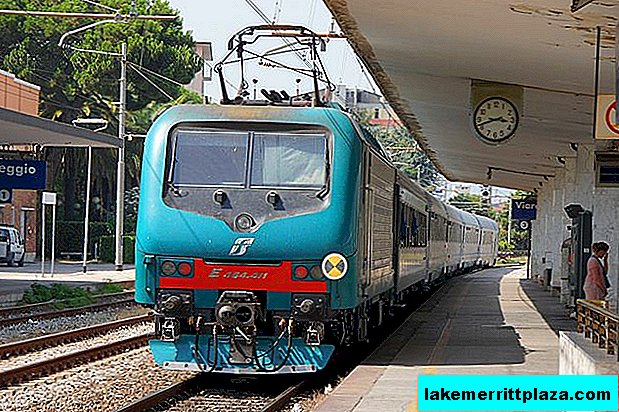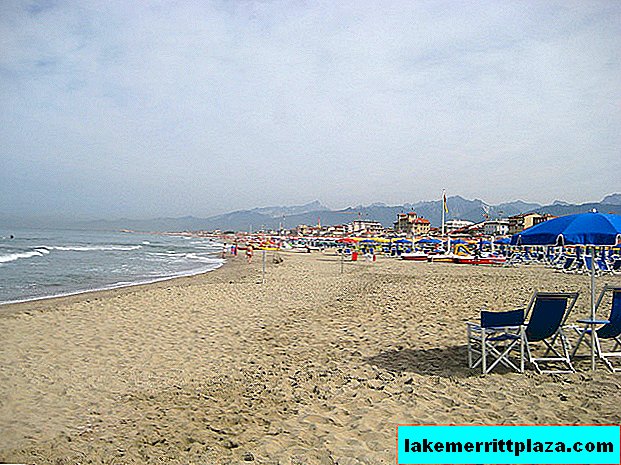There is a special place on the Ligurian Sea coast in the Italian region of Tuscany - the small resort town of Viareggio. Even in the century before last, many noble Italians, for the most part from nearby Florence, chose it for a summer vacation. Since then, this peculiar tradition has not changed - very many Italians still prefer Viareggio for a quality vacation, and this eloquent fact says a lot about this resort.
How to get to Viareggio in Italy
The question of how to get to Viareggio in Italy is so multivariate and problem-free that any detailed instructions here are unlikely to be needed. The resort has excellent bus and train connections with the largest cities in the country. And many of the most massive cities in terms of tourist flow are in a kind of equidistant "orbit" around Viareggio: Genoa, Milan, Turin, Bologna, Venice, Florence, Rome. And before the "supertouristic" Pisa and generally at a stone's throw. Only 20 minutes by train and you are there.

Viareggio connects with other Italian cities
If traveling on your own or a rented car - you have at your disposal beautiful Italian freeways, both paid and free.
In the event that the departure point is San Remo or even overseas Cannes, Nice or Monaco, at the same time you can enjoy dazzlingly beautiful landscapes on the road - the E80 motorway will take you to Viareggio in a few hours through the picturesque relief of the foothills of the Alps, bridges and tunnels.
If you want to race with the breeze almost close to the sea - take the SS1 highway, which for the most part of the route is still free.
Finally, if you are still quite far from Viareggio in Italy, or planning to arrive from abroad, including Russia, look for a plane ticket with arrival to Pisa at Galileo Galilei International Airport, and from there by train to Viareggio It will remain to overcome only about 20 km. Train tickets can always be found here.
Beaches of Viareggio
The indisputable advantage and pride of Viareggio is its endless beaches with clear water, silky sand and convenient entry into the sea. Absolutely all the beaches of the resort have long received the “Blue Flags” of the European Union for cleanliness, and every year they consistently confirm this high status.

All Viareggio beaches offer a high level of service.
There are many separate beaches on the coast. There are municipal ones - they have the most vacationers, especially on weekends, which is more than natural. But there are still more private beaches - local residents rent individual sites and equip them to the highest level.
At first glance, municipal and private beaches are not much different - they are all equally clean and beautiful. But private ones, of course, have important advantages - a higher level of service, the presence of some additional options (for example, pools with sea water, which will come in handy for you in case of strong sea waves).
By the way, remember that the municipal beaches of Viareggio for the most part are by no means free, they are simply much cheaper than private ones. A visit to the “state” beach will cost you 3 euros per day, and private - from 15 to 20 euros.

You can also choose a hotel with its own beach in Viareggio
You can also choose a hotel with its own beach. Along the coast stretches a whole string of comfortable hotels of category 4 and 5 stars. Just do not pull with the reservation, especially in season. Viareggio is a fairly popular summer destination. 2-3 weeks before the start of the trip, it is already difficult to find something worthwhile. You can always find your hotel with or without a beach using the link below.

Viareggio is definitely not the place to go "savage", but if for some reason you definitely do not want to pay to visit the beach, you have to stomp on foot to Lecciona beach, which is located between Viareggio and Torre del Lago. He is free.
And one more important thing. After 18:00, absolutely all the beaches of Viareggio close. In the literal sense of the castle - the beaches are fenced.
Viareggio landmarks in Italy
Despite the fact that Viareggio is Italy in every possible sense, it is in this city that almost the most characteristic feature of the country - the richest architectural heritage of ancient eras - is represented rather poorly. There are objective reasons for this. The city was never the capital of any of the countless principalities, it was also not at the center of epochal events in the history of Italy, and even the first mention of Viareggio in historical chronicles is not dated by the earliest Middle Ages.
Even those few architectural monuments that the city could boast of before the 20th century, were mostly destroyed during the Second World War. However, Viareggio, of course, has its own attractions.
Torre matilde
The first thing you should definitely see is the Torre Matilde Tower. It was with her that the history of the first organized settlements on the site of the current Viareggio began. The name of the tower comes from the name of Princess Matilda of Kanos, and this is what the historical curiosity consists of.
Historians of that time decided that the tower was built at the very beginning of the second millennium on the orders of the princess. In fact, the tower was erected much later - in 1534 by decision of the rulers of neighboring Lucca to protect against raids by motley robbers.

Matilda Tower - one of the oldest attractions of Viareggio
Throughout its history, Torre Matilde has managed to be a watchtower, a prison, a telegraph tower, and now for many decades serves as the “just” symbol of Viareggio. Now it hosts various cultural events.
Villa Paolina Bonaparte
The residence of Napoleon Bonaparte's sister is one of the most important attractions of the city. This is a neoclassical building built in 1882. At one time, very important cultural figures of Italy and all of Europe were here. Now the villa is open for tourists to visit, there are three museums at once: the archaeological museum of musical instruments and the art gallery of modern art.

Villa Paolina once served as the residence of Napoleon Bonaparte's sister
Pineta di Ponente Park
This place is called the "green pearl of the Italian Viareggio." It was created on the initiative of local authorities in the distant 1747. The idea was to build a park complex where city residents could take a walk in a peaceful environment away from strong sea winds. In the middle of the park there is a picturesque artificial lake with an “attribute” almost obligatory for such objects - graceful snow-white swans.
Villa Bourbon
This is another prominent and historically important place in the vicinity of the city. The villa is located along the route from Viareggio to Torre del Lago. Tourists can get inside the central building and enjoy the stunning interior decoration. The walls and ceilings of the villa are painted with amazing frescoes, the stairs and floors are inlaid with precious stones.

Villa Bourbon was built at the beginning of the XIX century.
Puccini Museum
Viareggio in the XIX century. became a favorite local summer vacation of the famous Italian composer Giacomo Puccini. In Torre del Lago, there is still a villa where Puccini spent most of his time. There is now a museum dedicated to the memory of a genius.
By the way, every year the city hosts the International Opera Festival in honor of the great composer.

Villa Puccini hosts the International Opera Festival every year
Church of Sant Andrea (Chiesa di Sant'Andrea)
Another historical, religious and architectural monument worth seeing in Viareggio is the church of Sant Andrea (Chiesa di Sant'Andrea). It's easy to find her - the street bears the name of the same saint as the church itself. Address - via Sant'Andrea, 55.

Church of Sant Andrea - one of the most important religious monuments of Viareggio
The church was built by decree of the Duke of Lucca Carl Louis Bourbon. The design and implementation of the Duke's plan was led by local engineer-architect Michele Chervelli. The church "officially" opened to parishioners in 1842.
Now inside the building are stored numerous Christian shrines, valuable works of art. Here, at one time, Antonio Maria Pucci preached and was buried, later ranked as a saint.
Cuisine and restaurants
Viareggio in Italy and real gourmets will not disappoint in the least. The local establishments serve truly refined dishes of traditional Italian cuisine with local nuances. It is here that you can try seafood prepared according to very original recipes.

Viareggio cuisine - traditional seafood, vegetable salads and pastas
Be sure to include traditional Tuscan vegetable salads in your gastronomic program - here they are seasoned with almost the best olive oil in the world. Also try local sheep milk cheeses, bean dishes, grilled vegetables and mushrooms, and absolutely amazing desserts.
Entertainment
Viareggio on the map of Italy is a very, very developed resort in terms of the entertainment industry. The city is literally “stuffed” with numerous opportunities for interesting, fun, and even profitable time spending: bars, restaurants, beauty salons, boutiques, a beautiful promenade, night clubs. For lovers of outdoor activities, any options are available: windsurfing, yachting, scuba diving, boat trips, golf courses, bike rental and much more.
As for the events, Viareggio is not deprived of them either. In high season, there are various concerts and festivals, the central place among which is the famous Carnival. An enchanting procession led by gigantic-sized parody dolls takes place here every year from the century before last, namely, from 1873.
A curiosity is also associated with this event - the local nobility decided to arrange a kind of parade of carnival carts in the city, while the poor townspeople, who did not have special respect for the aristocracy, joined the procession, dressed up in carnival costumes, making fun of local politicians.
Carnival events occur in February and last until the very beginning of March.
Other interesting articles:
- What to see in Florence in 1 day: itinerary
- Pisa Airport "Galileo Galilei". How to get from the airport to Pisa, Florence and other cities of Tuscany
- Tuscany: 6 most interesting places in the region
- Lucca is a tower city in Italy
- Sights of the city of Siena in Italy: what to see first








